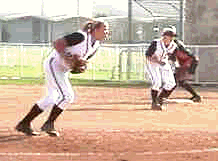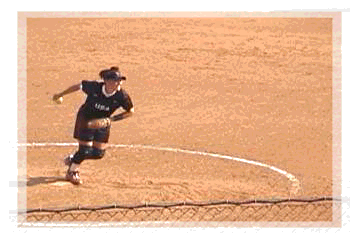|
by Gerald Warner, Softball Pitching
Instructor

As a pitching
instructor, I always encourage a pitcher to implement every weapon
in her arsenal to (1) throw the ball at maximum speed, (2) throw it
with accurate placement, and (3) make breaking pitches move better
than ever before. Modifying the start-up movements in the
early part of the pitching routine can substantially increase the
speed at which a fastball is thrown. 
At the start of the pitching sequence when
throwing a fastball, a typical "leap-and-drag" pitcher starts a
transfer of her weight from her rear leg to her front "push-off" leg
to give a strong push against the pitching rubber with her
pitching-side foot. Although often not emphasized by
pitching coaches, this forward lean
to create a transfer of weight is the start of a series of
events…all of which happen in less than half-of-a-second…that
determine the ultimate speed and placement of the
pitch.
1. The rapidity
and completeness of the weight transfer from back leg to front leg
directly affects...
2. The speed of the stride leg going
forward, which affects...
3. The length of the stride,
which affects...
4. The extent of "opening" of the trunk,
which affects...
5. The "closing" of the trunk, which
affects...
6. The "closing" of the shoulders, which
affects...
7. The speed of the final downswing of the arm
(the "arm whip"), which affects...
8. The ability to add a
strong wrist snap, which ultimately affects...
9. The
SPEED and the CONTROL of the pitch!
Therefore, a
primary goal in the mechanics of throwing a fastball should be to
maximize the weight transfer, which creates the power for the
push-off from the pitching rubber. 
We always encourage leaping-style pitchers to use their
body weight to help with the push-off. As the weight
transfer from back leg to front leg is taking place, let the upper
torso begin a "fall" forward…no bending at the waist is
necessary…just a forward fall of the erect body to get an
"explosive" drive off the pitching rubber.
Veteran
U.S.Olympian Lisa Fernandez aggressively leans
into her
push-off to get maximum power from her drive
leg.
This
feeling of "leaning" with the entire body (again, NOT
at the waist) can substantially increase the subconscious
need to push harder with the push-off foot and create a greater
speed of the stride leg to avoid the consequences of "falling"
forward. The result is a faster and longer stride, correct
landing of the stride foot, and a "strong front wall" set up by the
stride leg, all of which result in a harder-thrown
fastball.
This "body lean" is always just a slight
lean…the best pitchers lean
(without counting a waist
bend)
to the 1:30 or 2:00 position. A good body
lean
can help substantially increase the speed
of your fastball.
DRILL: To practice this "body lean"
concept, stand in your normal position on the pitching
rubber. Without winding up, keeping your body erect, start a
slow "fall" forward. Don't let your non-pitching leg take
the stride until the last possible instant. Did you feel the
need to quickly push-off the rubber so your stride leg could save
you from falling?
DRILL: Stand on the pitching rubber
as if you are going to pitch, directly facing your
(strong) parent or coach. With his/her hands on your
shoulders, and without bending your body at the waist, gradually
start falling forward…don't worry, your partner's hands will stop
you from falling. As you continue to slowly fall, start
raising your stride foot until you feel all of your weight pushing
against your pitching rubber foot. This is the pressure you
need to push off with in order to have a fast and long
stride. Now, have your partner (that you have
been trusting to not drop you on your face) push you back
into the upright position
The article
above can be downloaded and printed from Microsoft
Word

If you have questions
or need more information
E-mail us, or call Pitching Instructor Gerald
Warner in Colorado at (720) 200-4575
Home Page | | About Us | E-Mail
Us
More 1st-2nd Year
Pitchers | Beginning
Pitchers | Advanced Pitchers | Coaches &
Parents | 





